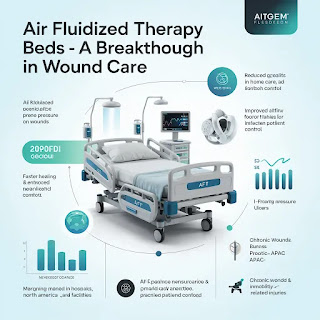Air Fluidized Therapy Beds Market: Transforming Wound Care Through Innovation
The air fluidized therapy beds market is experiencing remarkable growth, driven by increasing demand for advanced wound care solutions and an aging global population. These specialized medical devices are revolutionizing patient care by providing superior pressure redistribution and creating optimal healing environments for complex wounds.
Request a Sample: https://www.futurewiseresearch.com/contact.aspx?rpt=13469&type=requestsample
Market Growth and Projections
The global air fluidized therapy beds market is expected to
grow at 5.7% CAGR, reaching US$1,018.2 million by 2031 from projected US$690.7
million in 2024. This impressive growth trajectory reflects the healthcare
industry's growing recognition of the therapeutic benefits these beds provide.
The market is set to expand from an estimated USD 730.1 million in 2025 to
approximately USD 1,268.1 million by 2035, demonstrating sustained demand
across the forecast period.
The market's expansion is supported by multiple factors,
including rising incidence of chronic wounds, increasing prevalence of pressure
ulcers, and growing awareness of advanced wound care technologies. Healthcare
facilities are increasingly investing in these specialized beds to improve
patient outcomes and reduce long-term care costs.
Regional Market Dynamics
North America holds the largest share of the Air Fluidized
Therapy Beds Market, accounting for 39% of the market in 2024. The region's
dominance stems from its well-established healthcare infrastructure, higher
healthcare spending, and early adoption of advanced medical technologies. The
presence of major market players and favorable reimbursement policies further
strengthen North America's market position.
Europe and Asia-Pacific regions are also showing significant
growth potential, driven by improving healthcare infrastructure, rising
healthcare awareness, and increasing government initiatives to enhance wound
care management. The Asia-Pacific region, in particular, presents substantial
opportunities due to its large patient population and expanding healthcare
sector.
Therapeutic Applications and Benefits
Air fluidized therapy beds serve critical roles in treating
various medical conditions. Fluidization technology provides excellent pressure
redistribution and moisture management, both critical for treating stage III
and IV pressure injuries. The beds utilize millions of tiny ceramic beads
through which warm air is circulated, creating a fluid-like environment that
minimizes pressure points and promotes healing.
These specialized beds are particularly effective for
patients with complex wounds, including pressure ulcers, burns, and
post-surgical sites. The pressure redistribution surface pushes air through
millions of tiny beads, creating a fluid-like environment that feels similar to
floating on water, which significantly reduces pain and accelerates the healing
process.
The clinical benefits extend beyond wound healing. Patients
experience improved comfort, reduced pain medication requirements, and better
overall quality of life during treatment. Healthcare providers benefit from
reduced nursing time required for repositioning patients and improved patient
outcomes.
Reimbursement and Market Access
Healthcare reimbursement policies play a crucial role in
market growth. Medicare policy reimburses for home use of air-fluidized beds
only when the patient has Stage III or IV pressure ulcers and only after the
patient has completed at least a 30 day course of conservative treatment. This
coverage criteria ensures that the beds are used for appropriate clinical
indications while managing healthcare costs.
The reimbursement landscape is evolving as healthcare
systems recognize the long-term cost benefits of preventing complications and
reducing hospital readmissions. Value-based care models are increasingly
supporting the use of advanced wound care technologies that demonstrate
improved patient outcomes.
Challenges and Market Considerations
Despite the positive growth outlook, the market faces
certain challenges. High initial costs, limited awareness in some regions, and
the need for specialized training for healthcare staff can impact adoption
rates. Additionally, some clinical considerations, such as patient dehydration
risks and mobility limitations, require careful management.
The market is also influenced by the availability of
alternative wound care technologies and the need for continuous innovation to
maintain competitive advantages. Manufacturers are focusing on developing more
portable, cost-effective solutions to expand market accessibility.
Future Outlook
The air fluidized therapy beds market is poised for
continued growth, driven by technological advancements, expanding clinical
applications, and increasing healthcare investment. The development of portable
and more affordable models is expected to broaden market access, particularly
in home healthcare settings.
As healthcare systems worldwide focus on improving patient outcomes while managing costs, air fluidized therapy beds represent a valuable solution that addresses both clinical effectiveness and economic efficiency. The market's future success will depend on continued innovation, expanded reimbursement coverage, and growing clinical evidence supporting their therapeutic benefits.




Comments
Post a Comment